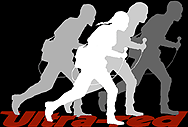
 |
|
|
|
|
ps/o5.a. ¿guesswork? ps/o5 public works | social factory | sound / body / labor
number 1
tracktitles
releaseavailability
trackdescription These events coincided with Ultra-red member's involvement in LA labor organizations such as Pride At Work / AFL-CIO and the LA Metropolitan Chapter of the Labor Party. Both organizations endorsed UNITE's anti-sweatshop crusade, compelling Ultra-red to attend rallies, demonstrations and teach-ins with the ever-present microphone and portable DAT (Digital Audio Tape-recorder) in hand. Adding to its archive of protest and teach-in recordings, Ultra-red also collected recordings of radio broadcasts surrounding the controversial "Between a Rock and a Hardplace" sweatshop exhibit at the Smithsonian.2 Representing the history of sweatshops from the murderous Triangle Shirt Factory fire through the founding of the garment worker's unions, the exhibit drew the ire of industry bosses and their cronies in Congress. In a display of congressional fury that has become all too common, some congressmen even threatened to pull federal funding from the Smithsonian (a public museum) if the exhibit wasn't either changed to include the viewpoint of the Garment industry or pulled entirely. In the end, a video produced by the American Apparel Manufacturer's Association was added as an addendum to the show. Armed with a battery of site-recordings, radio broadcasts and a smattering of Guess? commercials, Ultra-red composed material for the performance, "Guess Works". This material was showcased in a number of Los Angeles clubs including the group's April 1997 appearance at The Troubadour opening for Atari Teenage Riot founder, Alec Empire. The tracks were later compiled on the self-produced six-track audio cassette of the same name (since deleted). In October of that year, Ultra-red joined forces with visual artist Valerie Tevere to produce the solo-artist installation "¿Guess Work?" at the now-closed Spanish Kitchen Art Gallery blocks away from LA's garment district. The Tevere / Ultra-red collaboration featured a room filled with cartons made from peg-board. Sounds of protest, speeches, and congressional testimony on the Smithsonian exhibit emanated from the minimalist-inspired white cubes. On the wall, a facsimile of Jeff Wall's photograph "Outburst" (1989). The image was mounted with a quote from Wall in which the artist spoke of the "Outburst" image in purely art historical terms with no reference to the image's content depicting a man castigating a room full of garment workers. Since this work in 1997, Ultra-red has gone on to pursue a number of projects examining current labor organizing campaigns in Los Angeles. While the anti-sweatshop movement succeeded in activating college campuses across the country (a critical development in the growing anti-corporate globalization and pro-union movements), Guess? workers in Los Angeles are still without a union contract.3 After closing at the Smithsonian, the "Between a Rock and a Hard Place" exhibit found only one institution willing to mount the show: LA's own Museum of Tolerance. But like in DC, the LA showing attracted controversy. At one point Museum board members and donors Ð many of whom, like Guess?'s Marciano brothers, are figures in LA's garment industry Ð threatened to withdraw financial support from the Museum. In the end, after a series of compromises (including no official publicity for the exhibit) the show enjoyed a brief run at the Museum of Tolerance closing in the Spring of 2000. With nowhere to go once the run concluded, the exhibit suffered the summary fate of ending up in the MOT dumpsters. That was, until a clandestine artists' collaborative called Dispute Resolution Services salvaged pieces of the exhibit. Weeks later, the dumpster-dived fragments showed up in the "Nonzero Sum Games" show at the Gene Genies Worldwide Gallery.4 Today, the exhibition pieces remain curated in the basements of a few LA artists: bitter remnants of a history so many desperately wish to forget and other consider too immediate for the polite milieu of museums.
¿guess work? was presented on 230497 in performance at the troubadour, west hollywood, california, hosted by public space. music concretized by marco _ social realized by dont all tracks written and produced by ultra-red. recorded at voltage, except tracks 1, 3 and 5 recorded live in public space 230497. design by thaemlitz. copyright & publishing ultra-red 1997. ultra-red would like to thank the following for their participation and facilitation of this project: first and foremost thanks to red leader for engineering the public space performance. thanks to the people at public space: lynn hasty and john tejada, as well as alec empire for providing the audience. thanks also terre thaemlitz, spanish kitchen collaborator valerie tevere, and marcela weintraub, santiago, chile for the mall recordings. gratis voychek szaszor at spanish kitchen (rip). special thanks go to leslie ernst, sheila pinkel, judy branfman and the others with common threads artists collective. 1 An on-line version of the Common Threads' history of garment work in Los Angeles, "Hidden Labor" can be found at http://www.usc.edu/isd/archives/la/pubart/Downtown/HiddenLabor/. 2 On September 23, 1997 Pacific Radio's "Democracy Now!" aired a debate between defenders and detractors of the Smithsonian exhibit. See the following website for a RealAudio version: http://www.democracynow.org/archive/index.html. 3 The failure of the UNITE! campaign against Guess? is the subject of a study currently being written by Kent Wong and Ruth Milkman, authors of Voices From the Front Lines: Organizing Immigrant Workers in Los Angeles (Los Angeles: UCLA, Center for Labor Research and Education, 2000). For a more detailed study of garment worker organizing in Los Angeles, see Edna Bonacich, et al., Behind the Label: Inequality in the Los Angeles Apparel Industry (Berkeley: University of California Press, 2000). 4 For a detailed account of the exhibit's un-ceremonial dumping, see Michael Baers, "Fashion Victims: If you missed the Smithsonian's Sweatshop Exhibit at the Museum of Tolerance, or don't remember even hearing about it, you're not alone, " LA WEEKLY, May 12-18, 2000. The full text of the article is posted on the Sweatshop Watch website at: http://www.sweatshopwatch.org/swatch/headlines/2000/exhibit_may.html. |